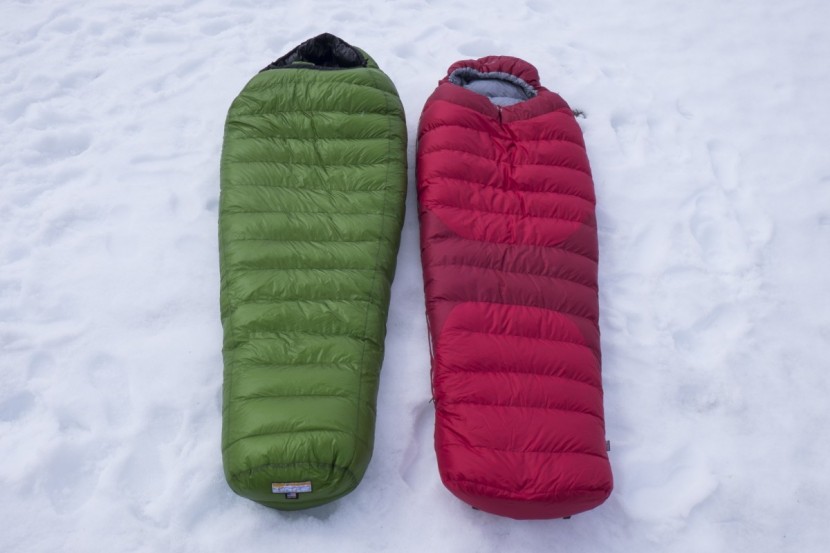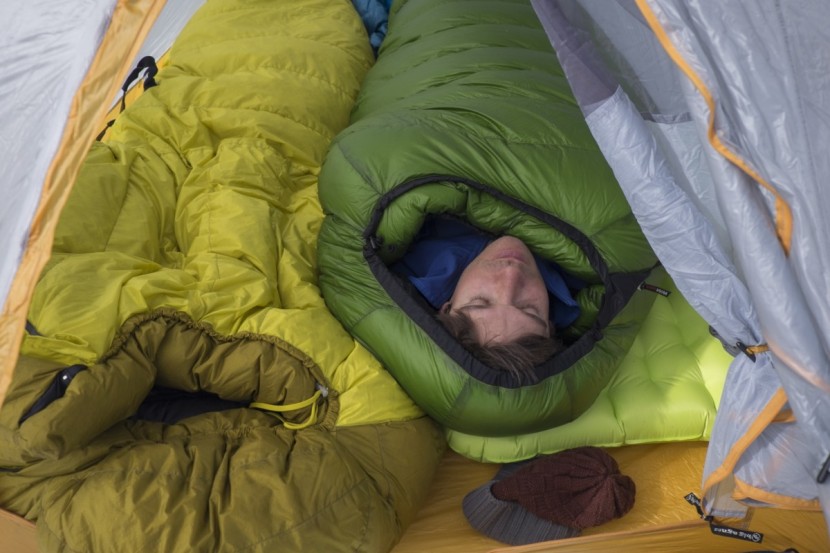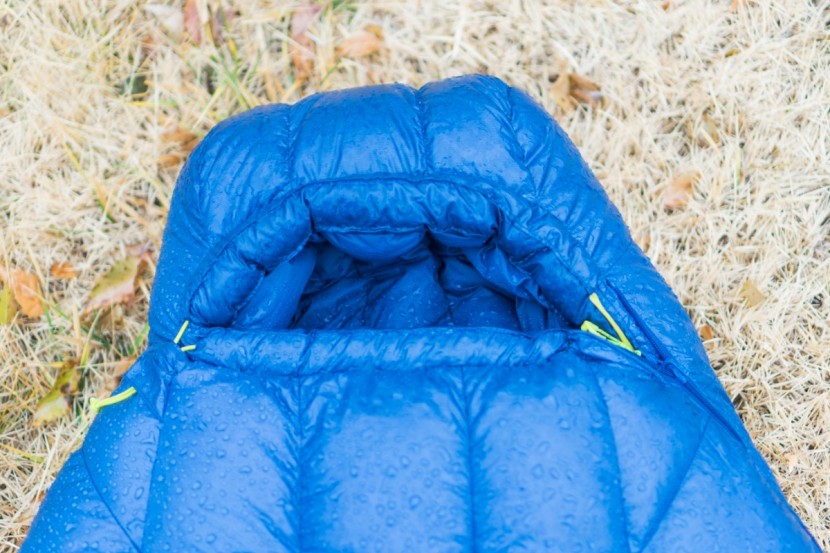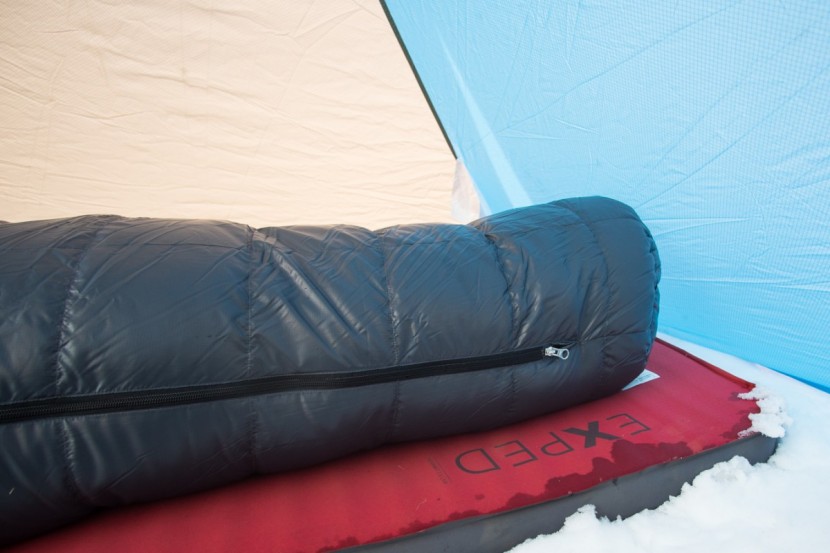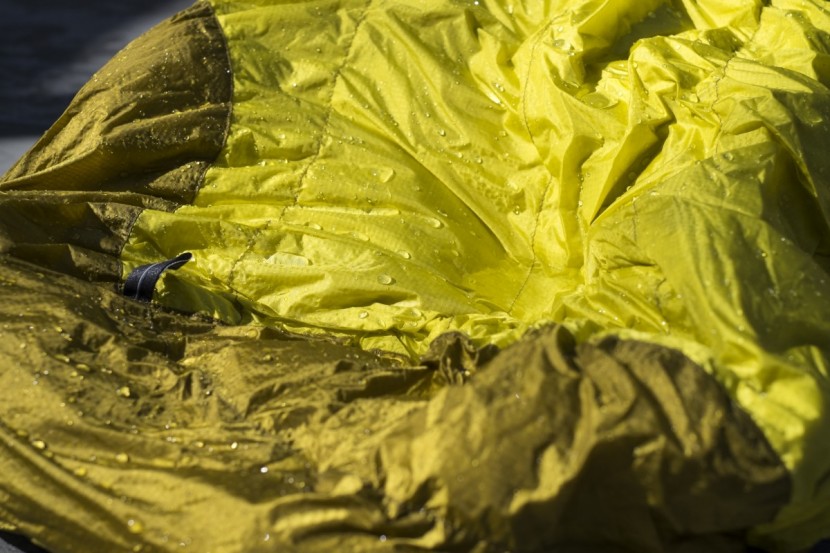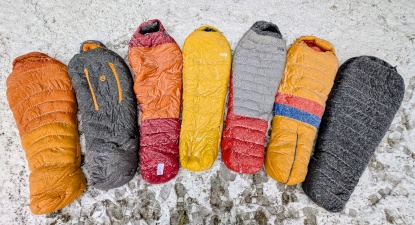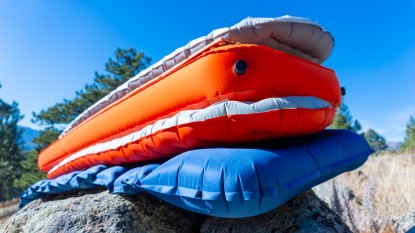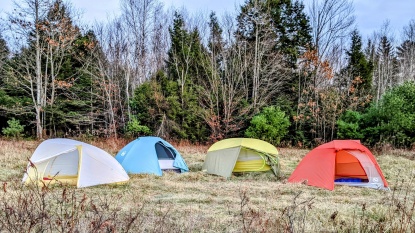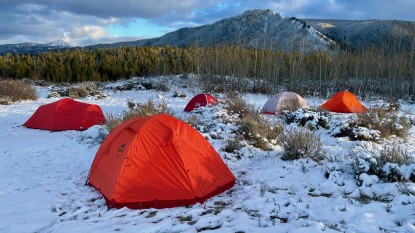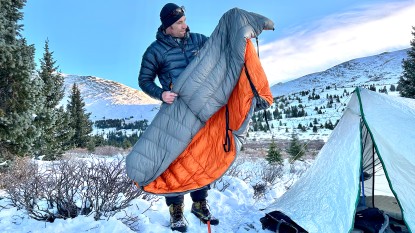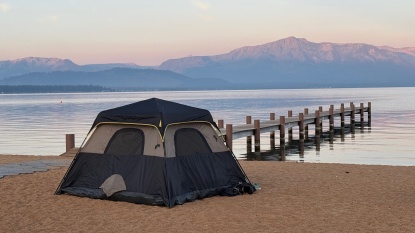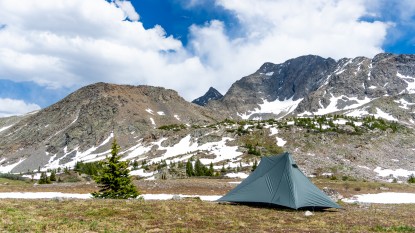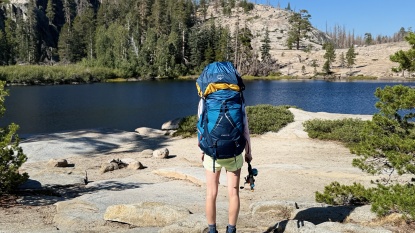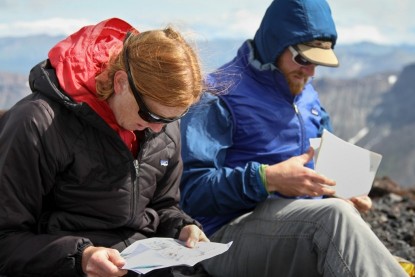High in the mountains, above the treeline, there is no roaring fire to warm your weary bones at the end of a long day. Alternatively, sunny winter days in Joshua Tree quickly turn into sub-freezing nights with howling winds, making your winter road trip in SoCal feel like “the poor man's Patagonia.” Either way, you need a warm sleeping bag that fits your budget and the demands of your cold-weather adventures. A sleeping bag is arguably the most crucial piece of gear in your overnight kit. Your tent will keep you dry, but a lofty down bag will take all your body heat and trap it around you in a warm cocoon.
For the weight-conscious adventurer, choosing a lightweight bag is an easy way to lower the overall weight of your gear, and some situations, a weather-resistant winter bag can eliminate the need for a tent or a bivy sack. For cold weather camping in the front country, the right down bag can keep you warm and comfy, and still be light and packable enough for shorter trips in the backcountry. Additionally, heavier bags are usually less expensive, so even if you're on a budget, you can be warm and sleep under the stars this winter. Read on to find out what features you need from a cold weather bag and check out which bags we recommend in our best winter sleeping bags review.
The Anatomy of a Down Bag
Baffle Construction
The baffle design is important when it comes to adjusting where the down insulation is in your sleeping bag. Many bags employ continuous horizontal baffles to keep the down distributed throughout the bag. This allows for you to shift more down towards the bottom of the bag so you can still sleep comfortably at warmer temperatures. By sleeping on top of much of the down insulation, you compress it and reduce its insulating ability, thereby decreasing warmth. Conversely, you can shake the insulation to the top of the bag on cold nights to increase warmth. Be aware that if you aren't mindful of where down is distributed, you could create cold spots.
Vertical baffles don't allow this same customization. Some bags have a hybrid design of vertical and horizontal baffles, allowing for down insulation adjustments in some areas, and keeping the down evenly distributed in key spots.
Hood
Most heat loss occurs through the head. Therefore, a snug-fitting, well-insulated hood is essential for a warm night's sleep in frigid temps. When weight is a concern, head-hugging hoods are a warm, efficient choice. Wider hood designs are great for folks who are spending many nights in a row in their bags and prefer a variety of sleeping positions. When you are trying on a sleeping bag, cinch the hood all the way up and pay attention to how much of your face is exposed. How does it feel when you turn your head to the side? Do you primarily sleep on your side or your back? If you are primarily a side sleeper, then you'll probably prefer a bag with a deeper, wider hood.
Cinch cords are also an important consideration. Our favorite designs rely on two cords, one that encloses the face, and another that keeps the bag snug under the chin, working in tandem with the draft collar to keep cold air out of the back, while allowing your mouth and nose to take in the night air.
Draft Collar
The draft collar is an insulated tube that fits around your neck and hopefully fits snuggly under your chin. All the winter down bags have draft collars to prevent cold air from entering through the hood. Look for thick, lofty draft collars with a dedicated cinch cord and closure system. Less ideal are drawstrings on outside of the bag, requiring us to contort ourselves to reach outside the warmth of the bag to tighten down the hood. Typically the best collars have their own independent cinch cords for the hood and draft collar that you can operate from inside the sleeping bag.
Draft Tube
A full-length draft tube is critical to guard you against cold air and moisture that enters the bag through the zipper. We feel that the most effective draft tubes have ample amounts of insulation and hang down over the zipper.
Footbox
Tighter fitting foot boxes are more thermally efficient and will keep your feet warmer than wider foot box, but a wider foot box makes room for water bottles and boots. You can always reduce dead space in any of these bags' foot boxes by shoving a jacket or some extra clothes at the bottom.
Zippers
The best zippers have some stiff strip lining on either side. The stiff lining leads to easy zipping and less snagging. Snagged zippers can usually be mitigated by carefully holding the draft tube out of the way with one hand while working the zipper with the other. This isn't convenient if you're trying to get out of your bag quickly in the dark, especially with gloved hands. Regardless, make sure your shell fabric doesn't get stuck in the zipper, as careless tugging could rip a hole in the shell fabric.
Pockets
Stash pockets are useful for keeping headlamps, batteries, and phones warm and easily accessible in the dark. The pocket feature is a nice bonus but doesn't make or break our decision when choosing a bag. If there isn't a stash pocket, you can easily just put your things in a small stuff sack and keep it in the bag with you.
Shell Fabrics
Most winter down bags have shell fabrics with some degree of water resistance. Bags with higher denier fabric and a DWR treatment are going to be the most weather resistant, but some lighter shell fabrics have proved to be adequately water resistant enough to withstand frozen precip. If you plan on sleeping exposed without a tent or bivy sack, consider a more weather-resistant bag. Just know that lightweight, weatherproof fabrics are more expensive. If you're carrying a tent, then your bag only needs to be water-resistant enough to resist condensation and melting frost.
Types of Down
Down insulation is made from the tiny, fluffy particles that are found beneath a bird's feathers. The highest quality down comes from geese. Down's quality is measured in fill power, which is the number of cubic inches displaced by 1 ounce of down. You can also think of fill power in terms of loft. A bag with high fill power down will be thick and puffy, creating a large insulated barrier between you and the cold air.
The amount of down in the bag, known as the fill weight, also affects how warm the bag will feel after you've been in there for a while. That's how bags with lower-quality insulation can feel as warm as a lighter bag with higher fill power. It takes more 650 power down to insulate as well as 850 fill power down, which is why less expensive bags tend to be heavier. The higher the quality of the down insulation, the better the bag's warmth-to-weight ratio will be. 900 fill power is best down available, and it's very uncommon. The other top dogs in the review all feature at least 850 fill power down. Of course, high-quality down costs more, too.
Lower-cost bags often use down insulation from ducks. This type of down is generally much less expensive and has a lower fill power. If weight is less of a concern for your winter camping missions, a bag with duck down can keep you warm and save you a few hundred bucks.
Ethics?
The process of harvesting down is done in many ways. Some methods involve killing the birds (sometimes using the meat, sometimes not), while others take to live-plucking of breast feathers. The eider duck lines its nest with down, whereby harvesting is painless. Live plucking, which tends to occur on a regular basis, is considered a cruel and painful process by many animal rights activists. Some sleeping bag manufacturers choose to source the down from their products as ethically as possible. For example, Western Mountaineering gets naturally shed down from molting for their products, refusing to accept live-plucked down or down from animals that were force-fed. If this is an issue for you, seek out companies like Western Mountaineering and Patagonia who take ethically sourcing their materials seriously.
This is a great example of consumer choice making a difference, and now Rab, Thermarest, and Big Agnes only make down products that are Responsible Down Certified. This means they are following the sourcing guidelines laid out by the Responsible Down Standard. This organization provides manufacturers with a certification process that ensures the ethical treatment of the birds so you can feel warm in your sleep bag, and feel good that your purchase isn't causing any unnecessary harm. For more info, check out the website.
Hydrophobic Down
Hydrophobic coated down has the potential to radically address down insulation's only drawback- its susceptibility to loft loss from moisture. Nanotechnology coatings claim to prevent down from absorbing water and allow it to dry out faster once it does absorb water. Hydrophobic coatings have the potential to make a very good thing even better. But how much better and is it worth the additional 10% price increase?
Sleeping bags from Western Mountaineering rely solely on their shell fabrics for weather protection, and they seem to be doing just fine in our opinion. As of now, we haven't developed a way to test whether or not hydrophobic down significantly affects the re-lofting and drying times of the sleeping bags that use it. Currently, the weather resisting properties of shell fabrics are the key, observable factors that affect how much water a bag absorbs, or how fast it dries.
Caring for your Winter Down Bag
The single most important thing you can do to extend the life of your down bag is to store it as fully lofted as possible. Western Mountaineering includes huge storage sacks with their extremely lofty bags. If your bag is even slightly compressed in its storage sack, get a bigger one! For cleaning your bag, use a mild soap designed for cleaning down garments and sleeping bags. Do not use harsh detergents that could affect the DWR treatment on the shell or the relofting properties on the insulation.
Simple precautions like sleeping on a lightweight tarp will help protect your bag from abrasions and puncture wounds. If your bag does have an unfortunate encounter with a sharp rock or stick, or gets caught in a zipper, immediately patch it with whatever is available to prevent down loss. When you get out of the field, you can apply a more permanent patch job, and most manufacturers offer repair services at a reasonable price.
Dirt and oils can affect the loft and water resistance of your bag, so occasionally you'll need to wash it. Always use a front-loading machine on a gentle cycle when washing a sleeping bag, since an agitator could damage it, or even better, hand wash it in the bathtub. Use a techwash made specifically for down products. At OutdoorGearLab, we've used gallons of Nikwax Down Wash over the years with success. You may need to rinse it several times to remove all the soap residue.
To dry your bag, set the dryer on the lowest heat setting and through in a few tennis balls. The balls will help the down reloft. It can take a long time to dry a bag, so plan ahead and give yourself plenty of time to clean your bag before your trip, and make sure the bag is completely dry before you pack or store it.
EN Testing: Why We Don't Rely On It
The European Norm 13537 is a standardized test created to measure warmth. A copper mannequin dressed in long underwear and socks and equipped with 20 temperature-sensitive sensors lays atop a closed cell sleeping pad inside the bag being tested. The bag is elevated on a 12mm thick wooden platform. Inside a temperature-controlled room, the sensors and algorithmic models calculate the warmth of a given sleeping bag. The results are parsed into three categories:
Comfort Range: based on a standard woman having a comfortable night of sleep. We feel this is the most important number in the EN rating system since it actually reflects the temperatures the sleeping bag is designed for.
Transition Range: The standard person is curled up in their bag and fighting to stay warm, but probably not shivering. The limit of your sleeping bag is likely somewhere in this range.
Risk Range: Here the EN rating states that a strong sensation of cold is to be expected. Hypothermia is possible, and the bag should only be used in an emergency. Do not purchase your sleeping bag based on this number.
The EN Rating is just a comparative guide. Like all standardized tests, it often struggles to capture real-world conditions. For example, most of us are back sleepers so the test measure sleeping bag performance for that. But if you're a side sleeper and the bag is better designed to retain heat in a side sleeping position, the test will miss that.
Another factor to consider is the warmth of your sleeping pad. Most pads today are much warmer than the EN sleeping pad used in testing. The pad employed in the EN testing is a thin, closed cell pad. These typically have an R-value of 1. Today's pads are inflatable and relatively lightweight. A warmer sleeping pad means the less insulation you need from a sleeping bag.
Several sleeping bags reviewed here have no EN test rating. Having such tests done increases expenses while the value of the data gained from testing is debatable. Furthermore, some bag designs might not be compatible with this standardized test. Quilts and non-traditional models often lack hoods or bottom insulation. The EN rating doesn't account for these designs.
Other real-world factors lead us at OutdoorGearLab to take the EN rating with a large grain of salt. Sleeping positions, clothing worn, type of tent or shelter, and the food and drinks you consume before hitting the hay. Perhaps most importantly, the fit of the bag plays a pivotal roll in warmth. We prefer to rely on our testers' warmth assessments.

